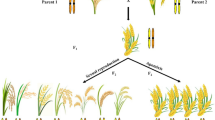Abstract
A detailed analysis of microsporogenesis was carried out in three diploid lily cultivars (2n=2x=24) and three diploid interspecific hybrids (2n=2x=24) using DNA in situ hybridisation methods (GISH and FISH). In cvs. Gelria (Lilium longiflorum; L genome), Connecticut King and Mont Blanc (both Asiatic hybrids; Agenome) meiosis was regular and only haploid gametes were formed while the three interspecific hybrids between L. longiflorum×Asiatic hybrid (LA) showed a variable frequency of meiotic nuclear restitution and stainable 2n-pollen formation ranging from 3% to 30%. An analysis of meiotic chromosome behaviour of the LA hybrids through GISH and FISH revealed that: (1) the parental chromosomes could be clearly discriminated into univalents, half-bivalents and bivalents in the PMCs; (2) in some of the PMCs the entire complement was present either as univalents or half-bivalents which had the potential to divide equationally (following centromere division) during the first division leading to first division restitution (FDR) gametes; (3) more frequently, however, in one and the same PMC the univalents and half-bivalents divided equationally whereas the bivalents disjoined reductionally at the same time giving rise to 2n-gametes that could vary from the well-known FDR or SDR 2n-gametes. We indicate this novel type of restitution mechanism as Indeterminate Meiotic Restitution (IMR). In order to confirm the occurrence of IMR gametes, the chromosome constitutions of eight triploid BC1 progenies derived from backcrossing the 2n-gamete producing the LAhybrids to the Asiatic hybrid parents were analysed through in situ hybridisation. The results indicated that there were seven BC1 plants in which FDR 2n-gametes, with or without homoeologous recombinations, were functional, whereas in one case the 2n-gamete resulting from IMR was functional. In the latter, there was evidence for the occurrence of genetic recombination through homoeologous crossing-over as well as through the assortment of homoeologous chromosomes. A singular feature of the IMR 2n-gamete was that although it transmitted a euploid number of 24 chromosomes to the BC1 progeny, the number of chromosomes transmitted from the two parental species was dissimilar: 9 L-genome chromosomes and 15 A-genome chromosomes instead of 12 of each.
Similar content being viewed by others
Author information
Authors and Affiliations
Additional information
Received: 15 May 2000 / Accepted: 4 December 2000
Rights and permissions
About this article
Cite this article
Lim, KB., Ramanna, M., de Jong, J. et al. Indeterminate meiotic restitution (IMR): a novel type of meiotic nuclear restitution mechanism detected in interspecific lily hybrids by GISH. Theor Appl Genet 103, 219–230 (2001). https://doi.org/10.1007/s001220100638
Issue Date:
DOI: https://doi.org/10.1007/s001220100638




